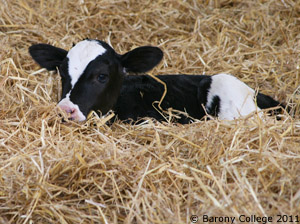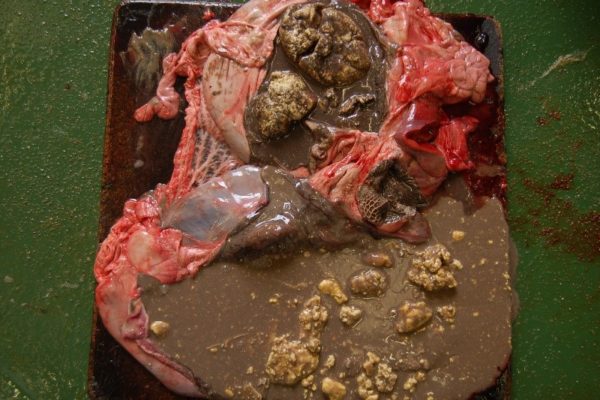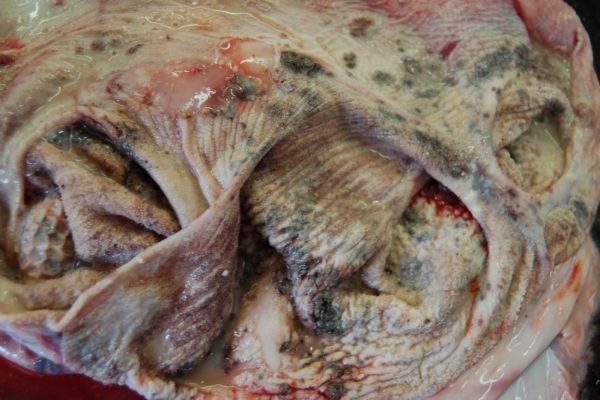Rumen Drinking in Calves – What is it and how to avoid it?
18 August 2021
Rumen drinking is one of the main causes of mortality that SRUC vets see in dairy calves. It can be the sole cause of death or a predisposer to other causes of mortality.
Rumen drinking is when the oesophageal groove reflex fails (the groove either closes incompletely or not at all) so that milk flows directly into the reticulo-rumen instead of the abomasum.
In the rumen milk undergoes bacterial breakdown and produces lactic acid and other volatile fatty acids, resulting in acidosis. This damages the lining of the rumen causing inflammation, as well as inhibiting curd formation of milk in the abomasum (photo 1).

Photo 1 - Rumen contents showing fermented milk (courtesy of SRUC Veterinary Services)

Photo 2 – Secondary fungal infection in a rumen-drinking calf (courtesy of SRUC Veterinary Services)
Inflammation affects oesophageal groove closure, exacerbating the problem and if it occurs on a regular basis, it causes thickening of the gut wall, reduced motility with slower passage rates of milk through the digestive tract and poorer nutrient absorption. Ulceration of the rumen may also occur, along with secondary bacterial and fungal infection (photo 2).
Affected calves are often underconditioned and dehydrated. They may also appear slightly depressed with an arched back and have a poor appetite and a weak suckling reflex. Other symptoms include recurring bloat, scouring with grey coloured manure, hair loss and poor co-ordination.
Possible risk factors include:
- Drinking from an open bucket versus a teat.
- Drinking speed – once calves learn to drink from a bucket they can consume milk very quickly. Widening the hole in a teat or worn or damaged teats will also increase drinking speeds.
- Height of feeding – the teat should be at nose height.
- Wrong temperature of milk (too cold) – it should be fed at body temperature (39˚C).
- Feeding waste milk.
- Low quality milk replacer and fed at incorrect concentration.
- Taste of milk.
- Irregular feeding times/infrequent feeding.
- Stress
- Underlying disease such as respiratory disease or scours which cause pain, distress or weakness.
The condition can be reversed if it is detected early enough, but chronically affected calves have a poor chance of recovery and so prevention is better than cure. Affected calves should be fed smaller volumes of milk more frequently via a teat/nipple bottle until the symptoms disappear. The oesophageal groove can be triggered to close prior to feeding milk by offering the calf a finger to suck. Tubing of a warm electrolyte solution, with bicarbonate present, can help combat ruminal acidosis in affected calves.
The oesophageal groove is less likely to form in calves that are weak, timid or stressed, as groove closure occurs when calves are excited about drinking milk. Water will not stimulate groove closure. Stress can be a primary cause of rumen drinking and includes things like long transport journeys, grouping of calves and changes in feeding management/techniques. The condition may not necessarily occur immediately after the stressor and can present with symptoms weeks later.
Early detection and treatment of calf diseases are crucial for the prevention of rumen drinking, and successful treatment of the primary disease will allow the calf to regain normal function of the groove.
Sign up to the FAS newsletter
Receive updates on news, events and publications from Scotland’s Farm Advisory Service
